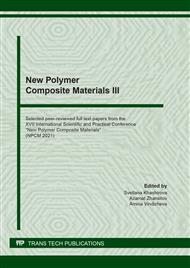[1]
D. Kumar, X. Wu, Q. Fu, et al., Development of durable self-cleaning coatings using organic–inorganic hybrid sol–gel method, J. Appl. Surf. Sci. 344 (2015) 205–(2012).
DOI: 10.1016/j.apsusc.2015.03.105
Google Scholar
[2]
C. Xu, C., W. Liu, Organic-inorganic hybrid corrosion protection coating materials for offshore wind power devices: a mini-review and perspective, J. Molec. Cryst. and Liq. Cryst. 710 (2020) 74–89.
DOI: 10.1080/15421406.2020.1830351
Google Scholar
[3]
A. Milionis, R. Giannuzzi, I. S. Bayer et al., Self-Cleaning Organic/Inorganic Photo-Sensors, J. Appl. Mater. Interfaces. 5 (2013) 7139-7145.
DOI: 10.1021/am401476k
Google Scholar
[4]
S. S. Latthe , R. S. Sutar, V. S. Kodag et al., Self – cleaning superhydrophobic coatings: Potential industrial applications, J. Prog. In Org. Coat. 128 (2019) 52-58.
DOI: 10.1016/j.porgcoat.2018.12.008
Google Scholar
[5]
M. Yu, Z. Cui, F. Ge et al., Simple spray deposition of a hot water-repellent and oil-water separating superhydrophobic organic-inorganic hybrid coatings via methylsiloxane modification of hydrophilic nano-alumina, J. Prog. in Org. Coat. 125 (2018) 15–22.
DOI: 10.1016/j.porgcoat.2018.08.020
Google Scholar
[6]
E. Yilgör, C.K. Söz, I. Yilgör, Wetting behavior of superhydrophobic poly(methyl methacrylate), J. Prog. in Org. Coat., 125 (2018) 530–536.
DOI: 10.1016/j.porgcoat.2018.07.018
Google Scholar
[7]
T.Shibata, H. Irie, K. Hashimoto, Enhancement of Photoinduced Highly Hydrophilic Conversion on TiO2 Thin Films by Introducing Tensile Stress, J. Phys. Chem. B. 107 (2003) 10696-10968.
DOI: 10.1021/jp0357830
Google Scholar
[8]
I.-D. Kim, A. Rothschild, B.H. Lee, D.Y. Kim, S.M. Jo, H.L. Tuller , Ultrasensitive Chemiresistors Based on Electrospun TiO2 Nanofibers, Nano Letters, 6 (2006) 2009–(2013).
DOI: 10.1021/nl061197h
Google Scholar
[9]
X.-T. Zhang, O. Sato, M. Taguchi, Y. Einaga, T. Murakami, A. Fujishima, Self-Cleaning Particle Coating with Antireflection Properties, J. Chem. of Mat. 17 (2005) 696–700.
DOI: 10.1021/cm0484201
Google Scholar
[10]
J. Li, Q. Sun, Sh. Han, Reversibly light-switchable wettability between superhydrophobicity and superhydrophilicity of hybrid ZnO/Bamboo surfaces via alternation of UV irradiation and dark storage, J. Prog. Organ. Coat. 87 (2015) 155-160.
DOI: 10.1016/j.porgcoat.2015.05.028
Google Scholar
[11]
V.S. Smitha, K.B. Jaimy, P. Shajesh, J.K. Jeena, J. K., K.G. Warrier, UV curable hydrophobic inorganic–organic hybrid coating on solar cell covers for photocatalytic self cleaning application, J. of Mat. Chem. A, 1 (2013) 12641-12649.
DOI: 10.1039/c3ta12314f
Google Scholar
[12]
S. K. Sethi, G. Manik, Recent Progress in Super Hydrophobic/Hydrophilic Self-Cleaning Surfaces for Various Industrial Applications: A Review, J. Polymer-Plastics Tech. and Engineering. 57 (2018) 1–21.
DOI: 10.1080/03602559.2018.1447128
Google Scholar
[13]
B. Ray, M.S. Lundstrom, M.A Alam, Can morphology tailoring improve the open circuit voltage of organic solar cells?, Appl. Phys. Letters, 100 (2012) 013307.
DOI: 10.1063/1.3672221
Google Scholar
[14]
C. Yu, S. Sasic, K. Liu, S. Salameh et al., Nature-Inspired Self-Cleaning Surfaces: Mechanisms, Modelling, and Manufacturing, J. Chem. Engineering Research and Design. 155 (2020) 48-65.
DOI: 10.1016/j.cherd.2019.11.038
Google Scholar
[15]
L.-H. Lee, W.-C. Chen, High-Refractive-Index Thin Films Prepared from Trialkoxysilane-Capped Poly(methyl methacrylate)−Titania Materials, J. Chem. of Mat., 13 (2001) 1137–1142.
DOI: 10.1021/cm000937z
Google Scholar
[16]
A. Nakajima, K. Hashimoto, T. Watanabe et al., Transparent Superhydrophobic Thin Films with Self-Cleaning Properties, J. Langmuir, 16 (2000) 7044–7047.
DOI: 10.1021/la000155k
Google Scholar
[17]
I.R. Segundo, E. Freitas, S. Landi, M.F.M. Costa, J.O. Carneiro, Smart, photocatalytic and self-cleaning asphalt mixtures: a literature review, J. Coat., 9 (2019) 696.
DOI: 10.3390/coatings9110696
Google Scholar
[18]
A.I. Aguilar-Morales, S. Alamri, B. Voisiat, T. Kunze, A.F. Lasagni, The role of the surface nano-roughness on the wettability performance of microstructured metallic surface using direct laser interference patterning, J. Mater. 12 (2019) 2737.
DOI: 10.3390/ma12172737
Google Scholar
[19]
O.A. Ryabkova, E.V. Salomatina, A.V. Knyazev, L.A. Smirnova, Synthesis of the Materials with a Switchable Wettability Based on Photosensitive Terpolymers Containing Poly(Titanium Oxide), J. Inorganic Materials: Applied Research. 10 (2019) 431-437.
DOI: 10.1134/s2075113319020369
Google Scholar
[20]
O.A. Ryabkova, E.V. Salomatina, L.A. Smirnova, Reversible Wettability Effect of the Organic-(≡TiO)n Inorganic Terpolymers Surface, Key Engineering Materials. 816 (2019) 266-270.
DOI: 10.4028/www.scientific.net/kem.816.266
Google Scholar


